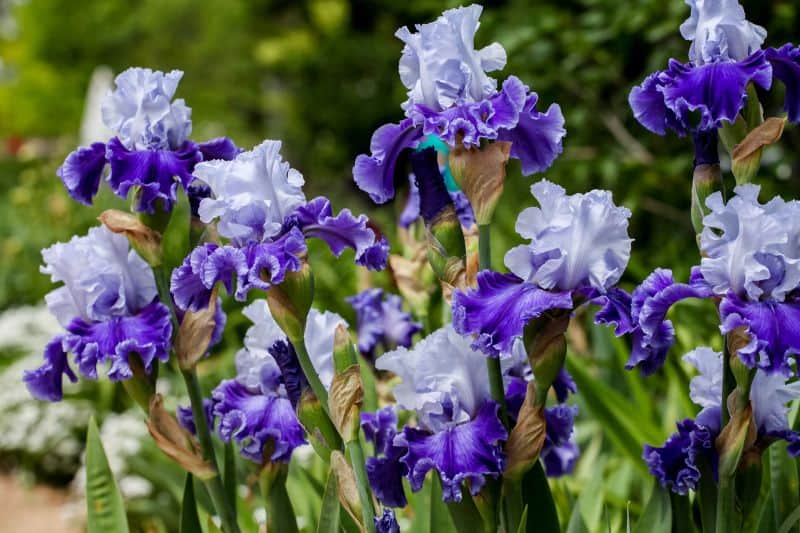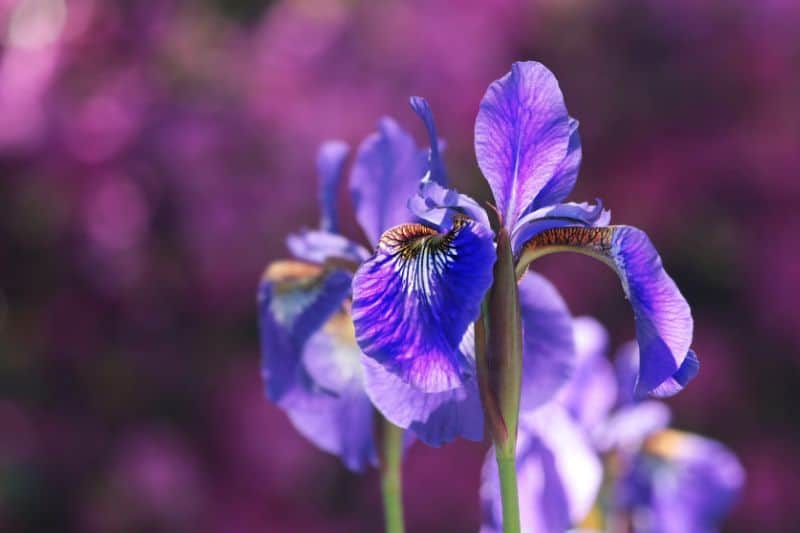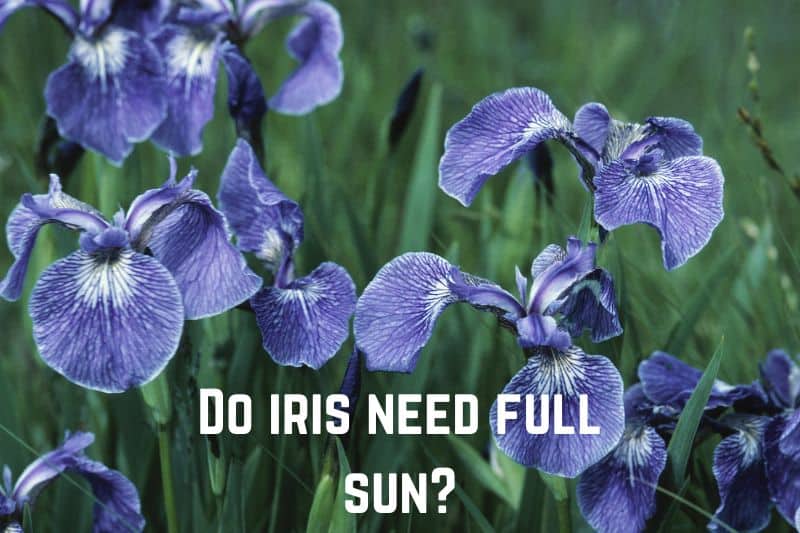Irises are among a gardener’s favorite blossoms to incorporate into a garden. However, these unusually structured and striking blossoms have particular growing conditions, including their light needs. So, before you choose where to place them in your garden, it’s important to figure out if an Iris needs full sun or not.
Their distinctively elegant blossoms feature a peculiar structure adorned with classic fleur-de-lis flower petals and finished with equally captivating shades. Whether added to a garden bed, border, or flower pot, these blossoms guarantee a layer of beauty and intoxicating fragrance.
Nonetheless, you want to ascertain the perfect growing conditions for these flowers to achieve the best results. This briefly detailed guide shares everything you need to know about the light needs of irises.
Read: Do Begonias Need Full Sun? (Prefer Partial Shade)
Do Iris Need Full Sun or Shade?
Irises may need full sun or shade based on their location. Typically, Irises need full sunlight to thrive and provide the best results. They can also grow well in partial shade or dappled light. Too much shade can cause irises to become floppy and weak, and they may not bloom as well.
However, in hot climates, they may benefit from some afternoon shade to protect them from the intense heat. So, if you are planting irises, it is best to choose a location that receives full sun for most of the day but has some shade during the hottest part of the day.
However, there is an exception to this. Growing irises in partial shade will only provide ideal results if they are planted in an extremely hot and dry climate. Doing so helps to ease heat stress and protect the plant from potential sun damage.
How Many Hours of Sun Do Irises Need?
The actual hours of sun exposure to irises highly depend on their location and placement. Generally, irises can grow in perennial gardens, rain gardens, and cutting garden gardens. You can even plant bearded irises in rock gardens and dry settings.
Generally, irises need at least 6 to 8 hours of full sunlight exposure to fully thrive and bloom abundantly. This is particularly true for bearded and bulbous irises. If grown in gardens with some barriers to the sun, you want them to enjoy longer periods of exposure.
On the other hand, if they grow in extremely hot climates, you can reduce the exposure length to just half a day. Alternatively, you can maintain the same length of exposure in partial shade. Combine your iris growing conditions for the best results by balancing sunlight and a cool atmosphere.
For example, an east-facing garden bed will provide the plants with as much morning sun leading into the afternoon. In the afternoon, the conditions get cooler as the plant is hitting its 6-hour mark.

What Happens If Irises Don’t Get Enough Sun?
Irises don’t do so well if they don’t get enough sunlight. In fact, in the standard climate (not too hot) exposure to direct sunlight for half a day or less (less than 6 hours) can easily affect the plant’s growth. Over time, limited exposure to enough sun will greatly affect irises.
If irises don’t get enough sun, they become easily susceptible to fungal disease and in worst-case scenarios, death. You will notice iris flowers begin to wilt while their leaves brown or form dark spots without sufficient sun exposure.
You may also notice firm leaf foliage and an upright form in limited sun exposure. However, your irises will yield very few blossoms. Without proper care or adding enough lighting, these plants will die out pretty quickly.
Can Irises Grow in Indirect Sunlight?
Irises can grow in indirect sunlight although they prefer direct sunlight. In direct sunlight, however, irises may not yield the best results, including a bountiful flower production. Nonetheless, these flowering plants can grow relatively well in indirect sunlight in two distinctive circumstances.
If you live in an extremely hot climate, it’s a good idea to place your iris in partially shaded areas to prevent sun damage. You can expose the plant to more forgiving and less intense morning sunlight and transition to shaded areas in the afternoon.
Moreover, irises can grow indoors where natural light access may be considered indirect. But, you have to be careful with these sun-loving plants if you choose to keep them indoors. Ideally, you want to place the plants on a windowsill where they will enjoy direct sunlight.
When grown indoors, irises need much of the already-filtered sunlight. So, you have to ensure the window is not in a shaded area or even partially blocked by anything.
Can Irises Grow in Shade?
Some irises tolerate partial shade while others, such as bearded and bulbous irises, do not tolerate any shade. Unfortunately, this can put irises at risk of heat stress and sun damage since the extended sunlight exposure emits a lot of heat.
Fortunately, there are ways to help cool irises without affecting their sunlight exposure. Some partial shade varieties can be paired with taller plants that provide partial shade. You can actually take advantage of this beneficial companion planting to choose ornamental plants that complement irises for an elegant and beautiful garden design.
On the other hand, less flexible varieties, like bearded or bulbous iris can be grown near heat-sinking sources. These include ponds or other outdoor water sources. You can even DIY a small pond in your garden to cool down your plants, including the irises.
In extremely hot locations, you can provide partial shade to irises in the afternoon as it gets a little too hot. Even sun-loving irises may be affected by these conditions.

Can Irises Get Too Much Sun?
Irises can never get too much sun. However, extended periods of sunlight exposure will also expose these plants to massive amounts of heat. Now, too much heat is what irises cannot tolerate. This is because heat can affect the growth and well-being of these plants.
This explains why even sun-loving irises should have dappled light or partial shade in extremely hot and sunny climates. Extreme heat increases evaporation, leading to the drying up of the soil your plant grows in.
This, in turn, interferes with the water supply of your thirsty irises, leading to a range of problems. These include failure to bloom. In worst cases, too much heat over long periods can even kill the plant.
Do Irises Need a Lot of Water?
Irises are water-loving plants and need a lot of water to grow and thrive. Irises don’t just need water to complete photosynthesis and hydrate other processes. The more water your irises can take up, the more flowers will bloom. Flowers will even be healthier, bountiful, and brighter.
An established iris will not need as much water as a growing one. But, it may need supplemental water during dry seasons or in extremely hot climates. Now, like other drought-tolerant plants, irises have evolved to survive for some time in case of water loss in the soil.
These plants naturally conserve water and use up this supply during drought or extreme evaporation and soil moisture loss. This supply will keep hydrating the roots and provide the plant with adequate water for photosynthesis. So, your plant enjoys a proper supply of food and energy.
But, once this supply is used up, this is when your plant is in real danger. You will start to notice wilted flowers and browned leaves, while the ground will look extremely dry. Eventually, the plant will stop producing more flowers. Limiting flower production is another way for these plants to conserve energy and delay death as much as possible.
Nonetheless, while irises require frequent watering from planting period to maturity, you have to avoid overwatering them. Overwatering irises is just as dangerous as loss of water.
This is because excess soil moisture can lead to leaf spotting and root rot. Watering should be limited to about three inches of the topsoil. Plus, the cooler it gets, from later fall through winter, the less frequently you should water them.
Read: Do Pumpkins Need Full Sun? (How Much Sunlight?)
How To Grow and Take Care of Irises?
- Plant irises during summer (mid-July to early August) to establish their roots before the colder season. Plant them sooner if winters in your area start earlier and later if you experience late winters.
- Plant irises as bare root rhizomes (these are thick stems resembling spring onions or other bulbs). Plant them horizontally about 4 inches deep with the top exposed while the roots are covered. Planting them too deeply can prevent them from growing.
- Leave at least 12 inches between plants to ensure they get adequate drainage, water supply, and sunlight exposure as they grow.
- After planting each rhizome, water them thoroughly until you notice the top soil is moist.
- Avoid mulching iris rhizomes as this can easily rot the roots.
- Irises should be exposed to full sunlight for at least 6 to 8 hours a day. Ensure your plant starts to absorb the less intense morning sun as it is most beneficial. In extremely hot climates, you can slightly reduce this exposure or start with morning sunlight exposure into afternoon partial shade.
- Irises prefer well-drained soils and prefer slightly acidic soils (at least a pH of 6.8).
- Irises require moist soils to enjoy a consistent water supply. But, you want to water the plant more frequently if you are in an extremely hot and dry area compared to cooler areas. Irises are prone to overwatering, so you have to be careful.
- Lightly apply fertilizer a month after planting irises, but go for fertilizer with low nitrogen content. Too much nitrogen can lead to root problems. Continue to lightly apply fertilizer every early spring.
- In case you notice browned leaves, always remove them and only leave behind healthy green leaves. This allows the plant to enjoy as much sunlight exposure and aeration. Removing old leaves will also encourage new and healthier growth.
- Once irises start to become talk, stake them to prevent them from falling over.
- Deadhead irises to encourage new flower production.
- After the blooming season, trim flowers to the stem to keep the plant healthy.
- After the plant is established, you will have to thin out irises every 3 years to prevent overcrowding. You may have to do this sooner if you didn’t leave enough space between each plant when planting them. Overcrowding will affect growth, preventing the plants from sufficiently taking up water and sunlight along with proper aeration.






